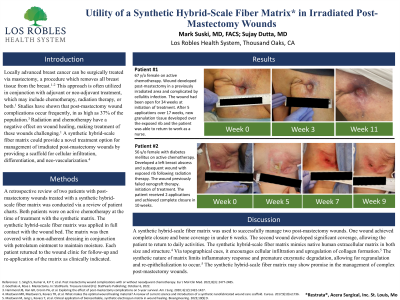Case Series/Study
(CS-137) Utility of a synthetic hybrid-scale fiber matrix* in irradiated post-mastectomy wounds

Locally advanced breast cancer can be surgically treated via mastectomy, a procedure which removes all breast tissue from the breast.1-2 This approach is often utilized in conjunction with adjuvant or neo-adjuvant treatment, which may include chemotherapy, radiation therapy, or both.1 Studies have shown that post-mastectomy wound complications occur frequently, in as high as 37% of the population.3 Radiation and chemotherapy have a negative effect on wound healing, making treatment of these wounds challenging.1 A synthetic hybrid-scale fiber matrix could provide a novel treatment option for management of irradiated post-mastectomy wounds by providing a scaffold for cellular infiltration, differentiation, and neo-vascularization.4
Methods:
A retrospective review of two patients with post-mastectomy wounds treated with a synthetic hybrid-scale fiber matrix was conducted via a review of patient charts. Both patients were on active chemotherapy at the time of treatment with the synthetic matrix. The synthetic hybrid-scale fiber matrix was applied in full contact with the wound bed. The matrix was then covered with a non-adherent dressing in conjunction with petrolatum ointment to maintain moisture. Each patient returned to the wound clinic for follow-up and re-application of the matrix as clinically indicated.
Results:
Patient ages were 56 and 67 years old at initial application. Both patients were on active chemotherapy, and one was also diabetic. Both wounds were in previously irradiated areas. One wound had exposed rib, and the other had a history of cellulitis and had been open for greater than 6 months. One patient received one application of the synthetic hybrid-scale fiber matrix and achieved coverage over exposed rib and closure in 5.5 weeks. The other patient has received 5 applications over a 17-week period. She has developed significant granulation tissue formation and reduction in pain, allowing for return to work.
Discussion:
A synthetic hybrid-scale fiber matrix was used to successfully manage two post-mastectomy wounds. One wound achieved complete closure and bone coverage in under 6 weeks. The second wound developed significant coverage, allowing the patient to return to daily activities. The synthetic hybrid-scale fiber matrix mimics native human extracellular matrix in both size and structure.4 Via topographical cues, it encourages cellular infiltration and upregulation of collagen formation.5 The synthetic nature of matrix limits inflammatory response and premature enzymatic degradation, allowing for regranulation and re-epithelialization to occur.5 The synthetic hybrid-scale fiber matrix may show promise in the management of complex post-mastectomy wounds.
Trademarked Items: *Restrata® Acera Surgical, Inc., St. Louis, Missouri
References: 1. Singh S, Kumar A, K.P Y, et al. Post mastectomy wound complications with or without neoadjuvant chemotherapy. Eur J Mol Clin Med. 2021;8(3): 2477-2485.
2. Goethals A, Rose J. Mastectomy. In: StatPearls. Treasure Island (FL): StatPearls Publishing; October 6, 2022.
3. Hammond JB, Han GR, Cronin PA, et al. Exploring the effect of post-mastectomy complications on 5-year survival. Am J Surg. 2020; 6(12):1422-1427.
4. MacEwan MR, MacEwan S, Kovacs TR, et al. What makes the optimal wound healing material? A review of current science and introduction of a synthetic nanofabricated wound care scaffold. Cureus. 2017;9(10):e1736.
5. MacEwan M, Jeng L, Kovacs T, et al. Clinical application of bioresorbable, synthetic electrospun matrix in wound healing. Bioengineering. 2023;10(9):9.

.png)